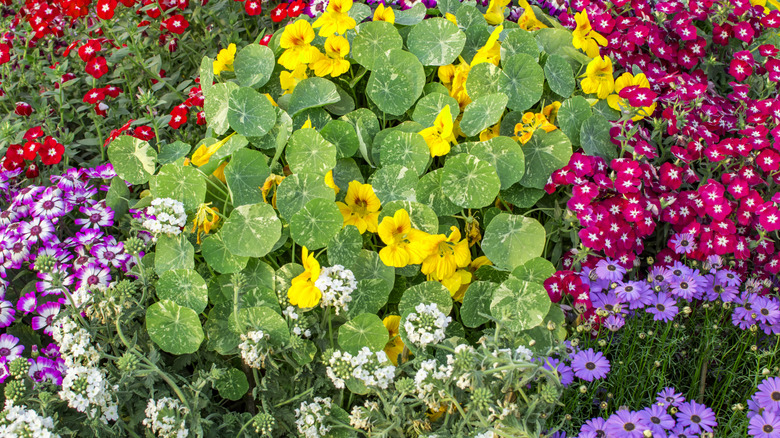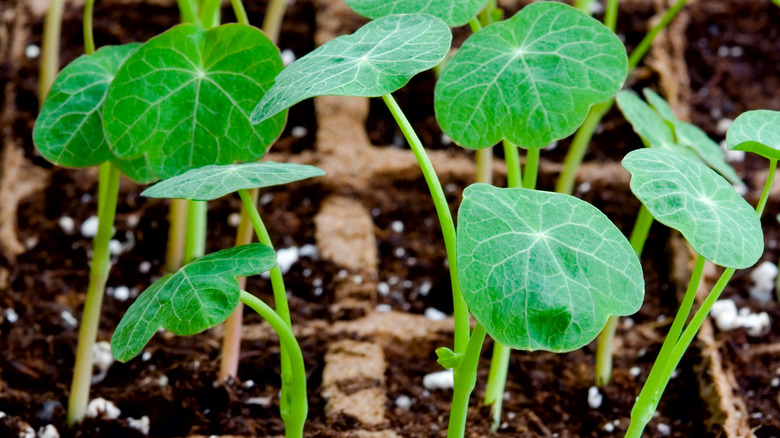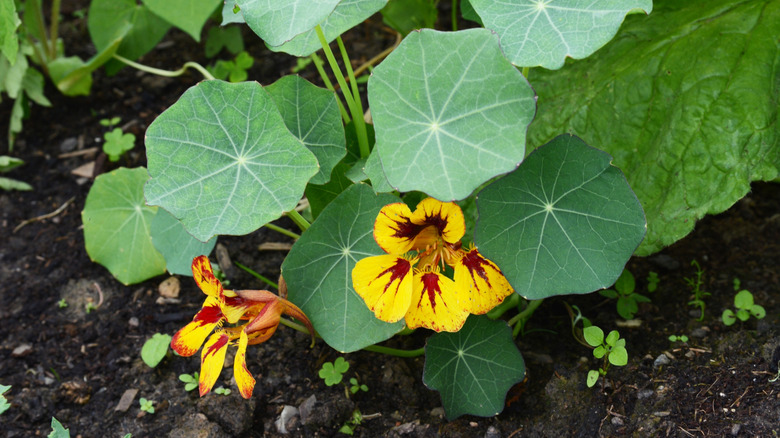The Gorgeous Flower You Should Seed Indoors In February For A Vibrant Spring Garden
Nasturtiums (Tropaeolum majus) are one of those gorgeous flowers that will add immense vibrancy to your spring garden. They'll start to bloom in late spring in warmer regions and fill your yard with an abundance of cheerful flowers all summer long. In most areas they'll happily grow as an annual, while in USDA hardiness zones 9 through 11, they can survive as perennials. Apart from just being pretty and adding color to your garden, nasturtiums are also very useful to have. They attract pollinators in droves and the leaves and flowers are edible. The green seed pods are commonly preserved in a vinegar solution as a substitute for capers. Starting these seeds indoors in February is the easiest way to get the earliest blooms. The seeds sprout quickly and your plants will be ready for transplanting as soon as the danger of frost is over. In fact, nasturtiums are one of the best flowers that beginner gardeners can easily grow from seed.
The species has blooms ranging from yellow to iridescent orange, but there are numerous hybrids and cultivars available now with floral colors in red and cream as well. You'll also find there are varieties that will grow in bush form while others like to trail along the ground, down a wall, up a fence, or even over anything else in the garden, if you let them. These plants can self-seed prolifically through your yard, so once you have them growing, you might be surprised to see them coming up again year after year.
How to start nasturtium seeds indoors
To start these little beauties indoors, you can either purchase some seeds or just collect them from plants grown by friends or neighbors – with permission, of course! These are definitely seeds you should be harvesting from your garden and replanting because they're just so easy to grow. Once you have some of those small seed pods, pop them in a paper bag or other suitable container to finish drying out. When it's time to start them indoors, prepare a few small pots or seedling trays by filling them with either potting soil or seed-starting mix. These plants aren't particular about soil types and will grow in just about any medium, as long as it's well-drained. Ideally, if you sow your seeds in February, they'll have plenty of time to grow and be ready for planting out after the last frost date.
If your seeds are quite hard and dry, soak them in water overnight as this will soften the outer seed coat and help them to sprout faster. Softer seeds that you've only recently collected, shouldn't need soaking because they'll germinate quite quickly. When you're sowing your seeds, cover them with around half an inch of soil as they need darkness to sprout. Place your pots in a warm spot, such as a sunny windowsill, and you should see evidence of growth within around 10 days. These seeds need warm temperatures above 65 degrees Fahrenheit to germinate well.
Planting your seedlings in the garden
Remember to harden off your seedlings gradually over a few days before planting them outdoors. They might suffer a little from transplant shock because they have a brittle taproot that doesn't like to be disturbed. This means that they may look somewhat wilted when you first plant them, but don't worry, because they should revive and look healthy again within a day or two. Alternatively, you may like to create your own seed starter pots from papier-mâché or by using cardboard toilet tissue tubes. These can then be planted directly into the garden without disturbing the roots of your young plants and will break down over time to nourish the soil.
As these garden favorites are so easy to grow from seed, you can get a bit creative and try some of the newer cultivars such 'Cherry Rose Jewel' which has gorgeous semi-double rose colored flowers, or 'Double Gleam' hybrids with their fragrant trailing blooms in shades of gold, primrose, red, and orange. These would look fantastic in hanging baskets. For something truly outstanding, how about 'Orchid Flame' which has stunning bi-color flowers in varying hues of yellow and red.


